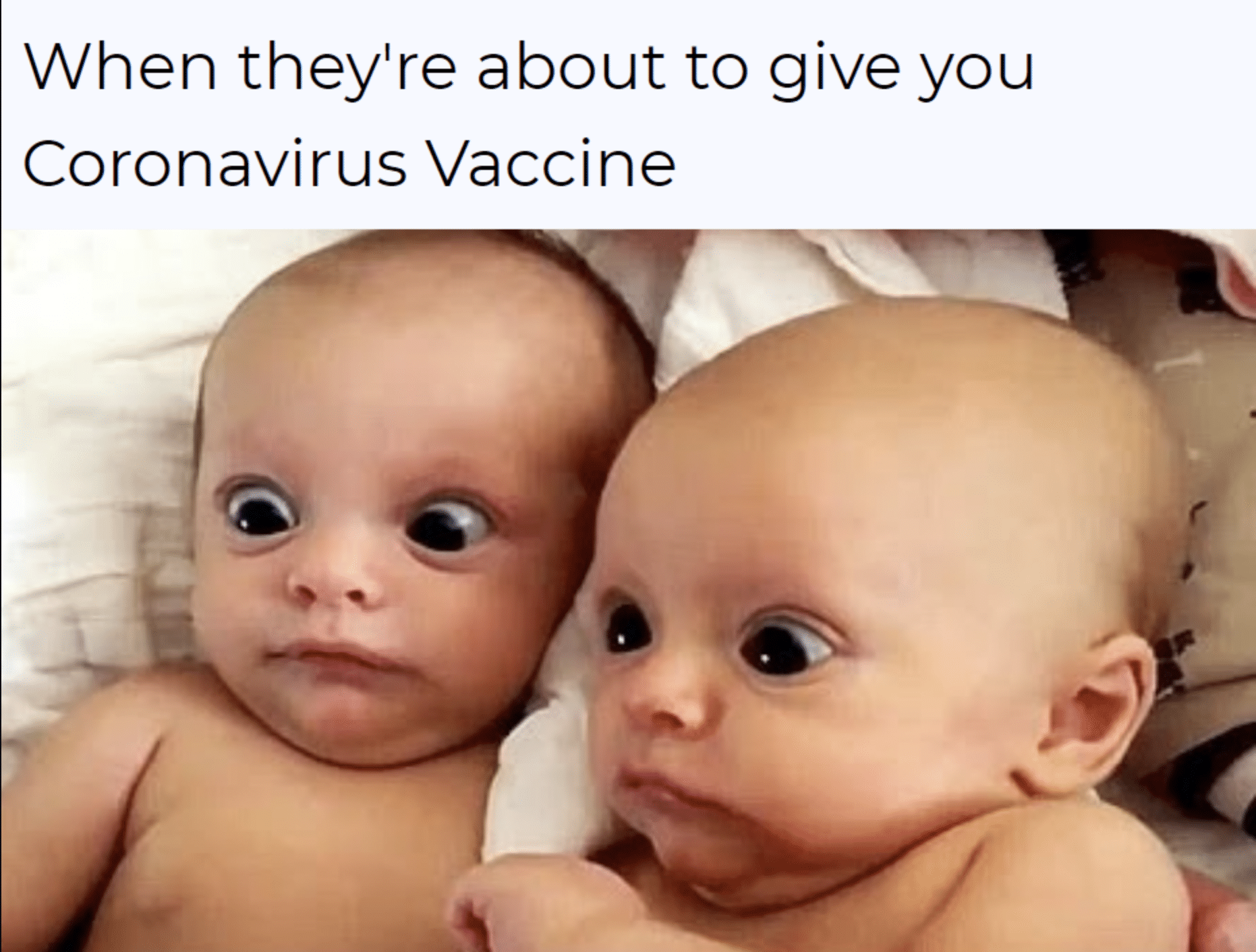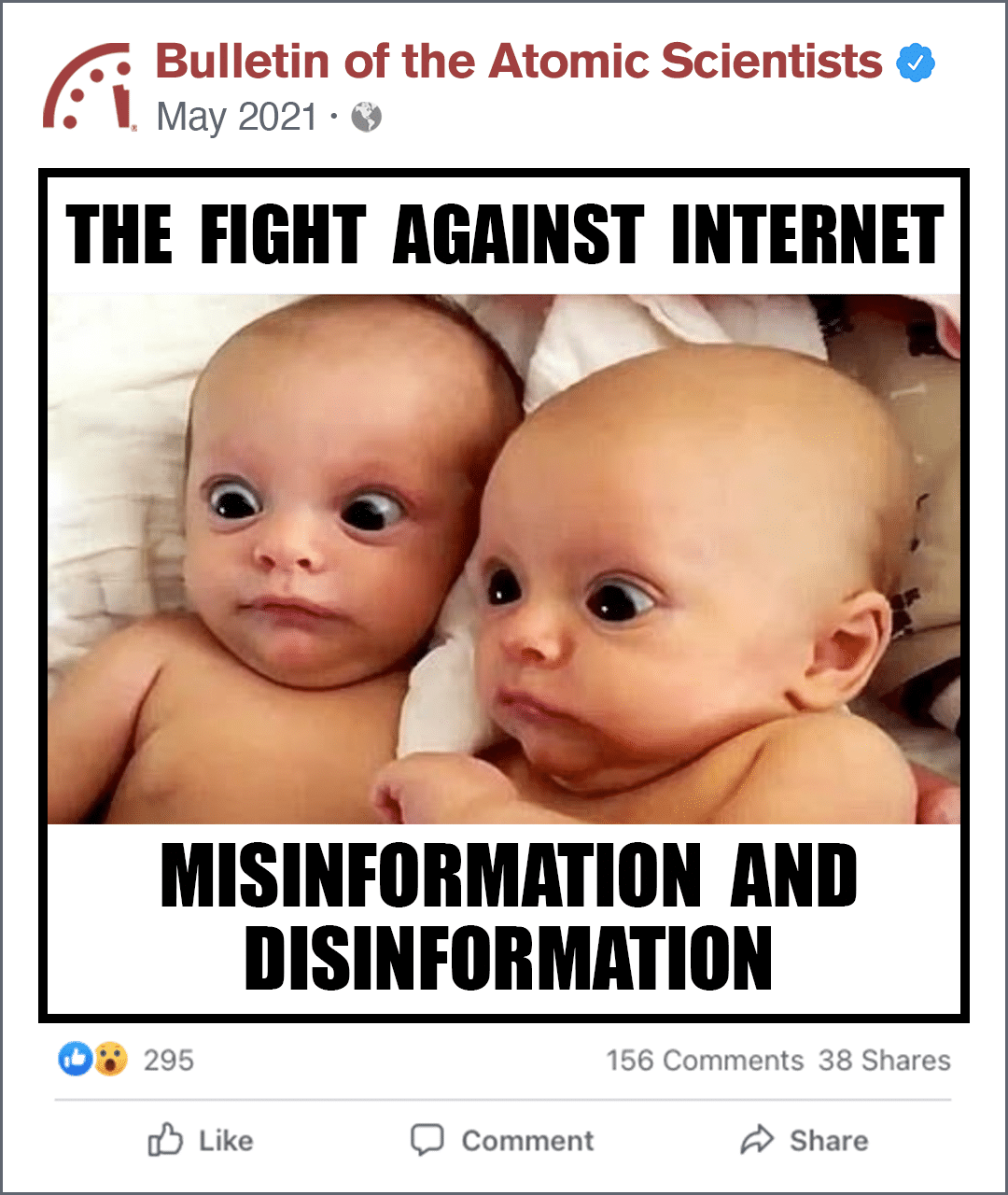Meme Warfare: AI countermeasures to disinformation should focus on popular, not perfect, fakes
By Michael Yankoski, Walter Scheirer, Tim Weninger | May 13, 2021
Meme Warfare: AI countermeasures to disinformation should focus on popular, not perfect, fakes
By Michael Yankoski, Walter Scheirer, Tim Weninger | May 13, 2021
Despite several alarming headlines in the press last year like “Deepfakes are coming for American Democracy” (Hwang and Watts 2020), the sophisticated, artificial intelligence- (AI-) generated images and videos called “deepfakes” didn’t end up influencing the presidential election (Simonite 2020), and they haven’t yet shaped major world events. Rather, as with the case of the viral video that appeared to show Joe Biden wearing a wire on the presidential debate stage (it was a shirt crease), cruder manipulations and simple misrepresentations can be far more effective and influential.
Researchers are only just beginning to understand the threat posed by multimedia (that is, visual and audio) disinformation. From QAnon conspiracy theories to Russian government-sponsored election interference, social media disinformation campaigns are a daunting front in online life, and identifying these threats amid the posts that billions of social media users upload each day is a challenge. To help sort through massive amounts of data, social media platforms are developing AI systems to automatically remove harmful content primarily through text-based analysis. But these techniques won’t identify all the disinformation on social media. After all, much of what people post are photos, videos, audio recordings, and memes.
Academic researchers, including us, have worked to develop AI systems with the technological sophistication to detect faked media items such as photos and videos (Yankoski, Weninger, and Scheirer 2020). In our analyses of disinformation in multimedia content, what we have found is that sophisticated faked content—often called deepfakes—just isn’t the most pressing problem. Through our ingestion platforms and media analysis engines, what we are seeing is not the proliferation of fake images, videos, and audio that are so real as to convince someone of something untrue, but rather the proliferation of narratives that emotionally reaffirm a belief that an audience already has (Theisen et al. 2020). Deepfake manipulations on the Internet are niche. The real challenge in using AI to detect multimedia disinformation lies in understanding much more crudely produced content: It is the meme that social media companies and policymakers need to worry about.

Memes and the power of shallow.
In 1976, the evolutionary biologist Richard Dawkins needed a term to explain how cultural artifacts evolve over time as they spread across society, replicating through imitative acts (Dawkins 2016). He coined the term “meme,” a portmanteau of the ancient Greek word for imitation, “mimeme,” and the English word “gene.” Since then, memes have become an essential form of visual communication. Anything a person can conceive of and express visually is potential meme material.
Memes generally are a kind of shallowfake. In contrast to increasingly realistic, AI-generated deepfakes, these are manipulations that range in production value from plausible to obviously fake. In other words, they’re easy to make. Shallowfakes can even be original images or videos that someone has simply relabeled as depicting something else or has subtlety edited to change the perception of the content, for example, by slowing down the video frame rate (Denham 2020). What is important is that they replicate and spread as rapidly as possible.
Shallowfakes are much better for meme making than deepfakes, which strive for realism. For shallowfakes like memes, it is often the case that the less they correspond to reality, the more effective they can be in spreading online and even swaying human behavior.
Take the saga of a Reddit group called r/wallstreetbets. In late January 2021, the “Redditors,” as the platform’s users are known, sparked an astronomical rise in the stock price of GameStop. A video game store popular in the early 2000s (Eavis 2021), GameStop had lost traction as shoppers and gamers moved online. For a few wild days in midwinter, however, the price of GameStop stock, which had hovered in the single-digit dollar range for much of 2020, rocketed to triple digits and closed at $347 on January 27 (Yahoo Finance 2021). Hedge funds that had placed bets against GameStop hemorrhaged money and the entire incident prompted congressional inquiries (Flatley and Wasson 2021), a Securities and Exchange Commission investigation (Newmyer and Zapotosky 2021), and numerous lawsuits.
A big part of the r/wallstreetbets story are the memes that Redditors used to generate an enormous response and to coordinate action by playing off of people’s emotions and beliefs. For example, one meme depicted a financial commentator who had a negative analysis of GameStop as a beggar. “On the way to the grocery store, found Andrew Left at his new job,” the post’s caption read. While, in this case, the Redditors weren’t pushing disinformation, their tactics perfectly illustrate the power of shallowfakes and memes to drive behavior. Another, perhaps more alarming, example of memes serving as powerful tools for disinformation has been anti-vaccination messaging during the pandemic (Buts 2021). Social media users have posted memes questioning the value of COVID-19 vaccines, saying, for example, that the flu vaccine hasn’t eliminated the flu. Others have linked the vaccines to autism. Such meme-based disinformation campaigns could reinforce existing divides in vaccine support (Funk and Tyson 2021).

AI for detecting disinformation.
Researchers have put significant resources into the creation of sophisticated AI systems to rapidly detect threats as they emerge in online social media networks. There are text-based hate speech detection systems (Peace Tech Lab; Woolley and Howard 2018; Technologies & International Development Lab n.d). One of us (W.S.) is developing sophisticated image manipulation detection algorithms to detect doctored images (Theisen et al. 2020; Yankoski, Weninger, and Scheirer 2020). Deepfake video detection systems have the capacity to both detect irregularities, such as noise inconsistency in the video itself (Guarnera, Giudice, and Battiato 2020; Verdoliva 2020) as well as differences between the affective cues contained in the audio versus the video components of a media item (Mittal et al. 2020).
The problem is that these technologies are often isolated from one another, and thus relatively incapable of detecting meme-based disinformation campaigns. While the technological advances in each of these various areas are laudable, researchers have yet to produce AI systems sophisticated enough to detect coordinated campaigns designed to manipulate how groups of people feel about what they already believe, which is the motivation for campaigns involving memes.
This kind of AI analysis is on another level entirely from all existing systems and technologies. This other level is semantic analysis, a methodology aimed at mapping the meaning of the disinformation campaigns themselves. For semantic analysis, it isn’t enough to detect whether a post contains a manipulated image, faked audio clip, or hate-speech. Algorithms need to be able to identify coordinated multimodal (i.e., text / image / video) campaigns deployed across platforms so as to inflame the emotional landscape around an audience’s beliefs. AI systems will need to understand history, humor, symbolic reference, inference, subtlety, and insinuation. Only through such novel technologies will researchers be able to detect large-scale campaigns designed to use multimedia disinformation to amplify or magnify how a group of people feel about their preexisting beliefs.
This is a much more difficult task than simply identifying manipulated multimedia, particular words in a hate-speech lexicon, or new instances of a known “fake news” story. Rather this requires developing the capacity for machines and algorithms to better grasp the complex and multifaceted layers of human meaning making. Systems capable of parsing the complicated layers of meaning deployed in shallowfakes like memes represent the very cutting-edge of AI systems and are the forefront of the foreseeable future of technological development in this space. In many ways this represents the transition from existing AI perceptual systems to nascent AI cognitive systems. The enormous difference in complexity and computing power between these cannot be overstated.
Just the beginning.
Systems capable of detecting deepfakes don’t actually do much to help counter the proliferation of disinformation campaigns deploying shallowfakes designed to magnify and amplify an audience’s preexisting beliefs. Likewise, systems focused on identifying problematic text also are inadequate to the task of parsing memes and shallowfakes. But imagine for a moment that AI researchers are able to develop semantic analysis systems, and that it becomes possible to detect these coordinated disinformation campaigns as they occur. What then? AI won’t be enough. The social media companies and policymakers will need to look at interventions, including software development, media literacy and education, and even new social norms. In other words, society needs a broad-spectrum approach to sufficiently prepare for the disinformation campaigns that are becoming increasingly common.
Such an approach should include the following elements: a) policy-level responses that more carefully consider the complex relationship between disinformation, democracy, and freedom of speech; b) information-sharing agreements designed to coordinate the sharing of information across government agencies as well as social media platforms for the rapid identification of and deceleration of disinformation campaigns in real time; c) media literacy education campaigns that educate and prepare users to identify trustworthy sources of information and fact-check or further analyze sources of information that seem questionable.
Some responses to disinformation might involve not technological fixes to remove content, but rather techniques to help users know what they’re consuming online. App developers should consider developing a “disinformation engagement metric” similar to screen-time counters and app-specific engagement statistics trackers. These would help users know more about the volume of disinformation that they are encountering. There are multiple hurdles related to this, but as the threat of emotional manipulation through disinformation continues to grow, policymakers and developers alike will need to develop new tools to help users navigate a rapidly evolving landscape.
As more of the human population gains reliable and fast access to the internet, an increasing percentage of people will become susceptible to campaigns intended to manipulate, magnify, and amplify their preexisting notions and emotional dispositions. Realizing when this is occurring doesn’t just require technological systems capable of identifying deepfakes, but rather systems with the ability to identify coordinated shallowfake campaigns across platforms.
But beyond the necessary advances in technology, we also need a multi-faceted response that integrates policy-level decisions, content moderation strategies, information sharing agreements, the cultivation of new social norms around disinformation sharing online, the development of new disinformation consumption/interaction tools at the software-level, and even social initiatives intended to help people interact in civic life rather than just in an online forum.
Editor’s note: Walter Scheirer was supported by the Notre Dame Institute for Advanced Study. Michael Yankoski and Tim Weninger were supported by USAID grant number 7200AA18CA00054. Portions of this work were supported by the Defense Advanced Research Projects Agency and the Air Force Research Laboratory under agreement number [FA8750-16-2-0173]
Together, we make the world safer.
The Bulletin elevates expert voices above the noise. But as an independent nonprofit organization, our operations depend on the support of readers like you. Help us continue to deliver quality journalism that holds leaders accountable. Your support of our work at any level is important. In return, we promise our coverage will be understandable, influential, vigilant, solution-oriented, and fair-minded. Together we can make a difference.
























Dawkins, ever “a Darwinian” argued (correctly, I believe) that memes survive and are transmitted within the community because of “survival of the fittest.” I opine that A.I. generated memes must be solidly “fit” to survive long enough to be a real danger. To quote A.E.Newman’s query: “What, me worry?”
That said, the danger is not zero. cartoonist Scott Adams observes that 25% of the population can be persuaded to believe anything, no matter how nonsensical.
It’s great that experts are and social media platforms are combating disinformation, and it’s a good idea to implement safeguards against deepfake technology. But we also have to consider its positive applications when used ethically. There is a lot of technology that we now use in our everyday lives that people once considered dangerous. With proper rules and regulations, I believe Deepfake and voice cloning has a lot of positive potentials.